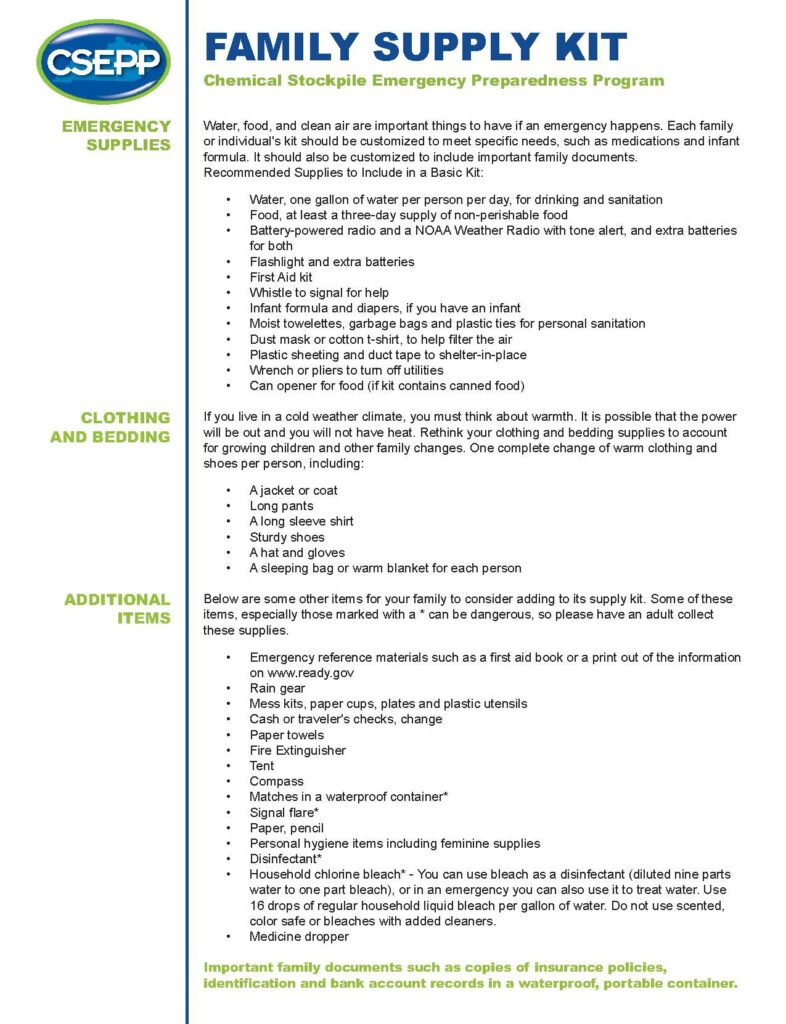Kentucky CSEPP designed a list of basic items every family should include in their Family Emergency Kit. This list can be customized to meet your family’s specific needs. Print a copy and discuss the items with your family then use it as a checklist when building a family emergency kit.

EMERGENCY SUPPLIES
Water, food, and clean air are important things to have if an emergency happens. Each family or individual’s kit should be customized to meet specific needs, such as medications and infant formula. It should also be customized to include important family documents.
Recommended Supplies to include in a Basic Kit:
- Water: one gallon of water per person per day, for drinking and sanitation
- Food: at least a three-day supply of non-perishable food
- Battery-powered radio and a NOAA Weather Radio with tone alert, and extra batteries for both
- Flashlight and extra batteries
- First Aid kit
- Whistle to signal for help
- Infant formula and diapers, if you have an infant
- Moist towelettes, garbage bags and plastic ties for personal sanitation
- Dust mask or cotton t-shirt, to help filter the air
- Plastic sheeting and duct tape to shelter-in-place
- Wrench or pliers to turn off utilities
- Can opener for food (if kit contains canned food)
CLOTHING AND BEDDING
If you live in a cold weather climate, you must think about warmth. It is possible that the power will be out, and you will not have heat. Rethink your clothing and bedding supplies to account for growing children and other family changes. Plan for one complete change of warm clothing and shoes per person, including:
- A jacket or coat
- Long pants
- A long sleeve shirt
- Sturdy shoes
- A hat and gloves
- A sleeping bag or warm blanket for each person
ADDITIONAL ITEMS
Below are some other items for your family to consider adding to their emergency kit. Some of these items, especially those marked with an * can be dangerous, so please have an adult collect these supplies.
- Emergency reference materials, such as a first aid book or a printout of the information on www.ready.gov
- Rain gear
- Mess kits, paper cups, plates and plastic utensils
- Cash or traveler’s checks, change
- Paper towels
- Fire extinguisher
- Tent
- Compass
- Matches in a waterproof container*
- Signal flare*
- Paper, pencil
- Personal hygiene items, including feminine supplies
- Disinfectant*
- Household chlorine bleach* – You can use bleach as a disinfectant (diluted nine parts water to one part bleach), or in an emergency, you can also use it to treat water. Use 16 drops of regular household liquid bleach per gallon of water. Do not use scented, color safe or bleaches with added cleaners.
- Medicine dropper
Important family documents, such as copies of insurance policies, identification and bank account records, should be placed in a waterproof, portable container.
Having Extra Supplies In Case Of An Emergency: It’s Scary Simple
When a storm is coming, you don’t want to run out of supplies like food, water, and snacks. Having extra supplies is as easy as picking up a few extras every time you go food shopping. YouTube, Feb 22, 2017, 0:29.
‘Scary Simple’ is campaigning to educate Americans how to prepare for and respond to emergencies. We strive to empower families to develop a plan to communicate in the case of a disaster. Find out more information on how to prepare for emergencies at Ready.gov.